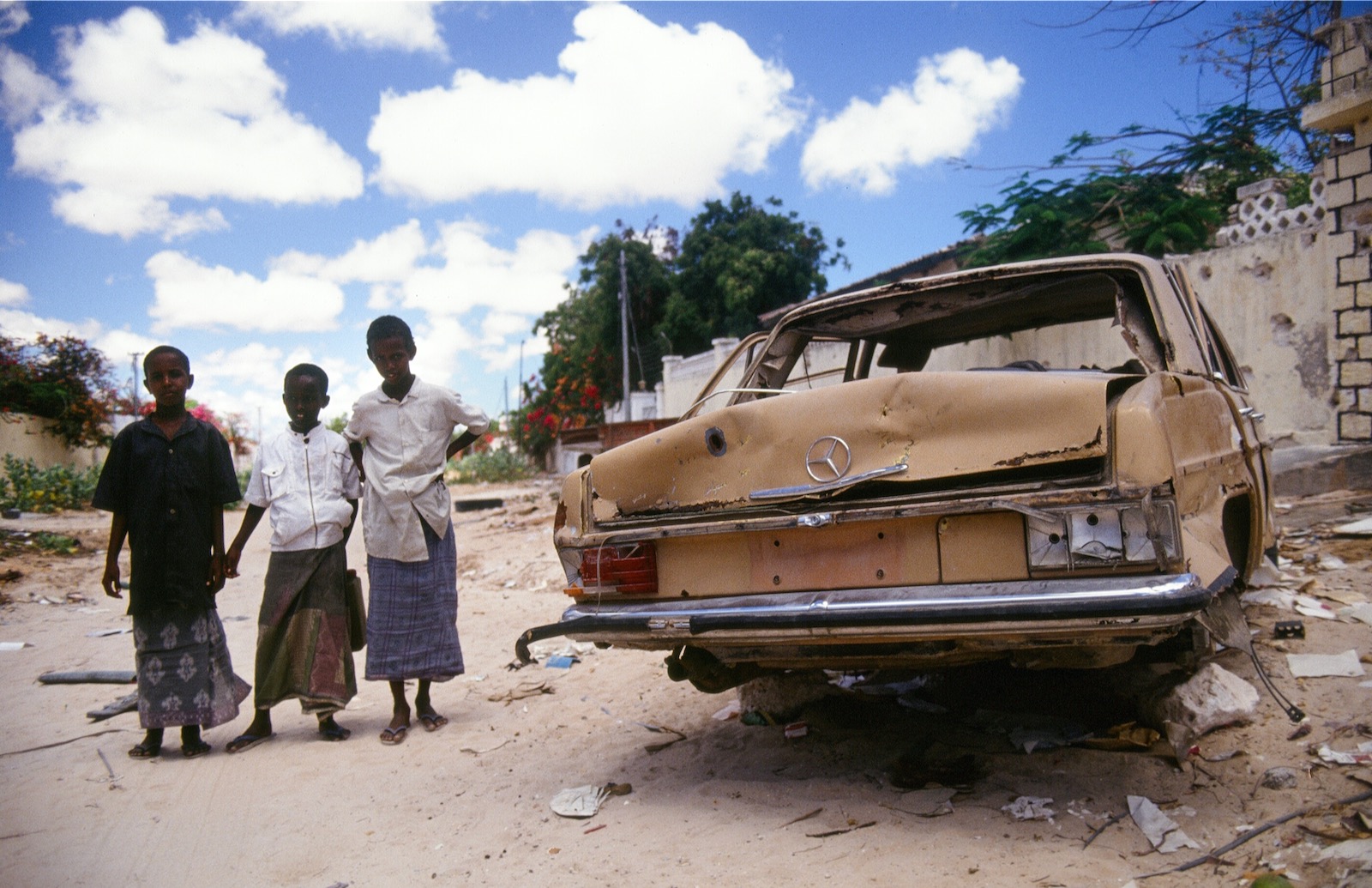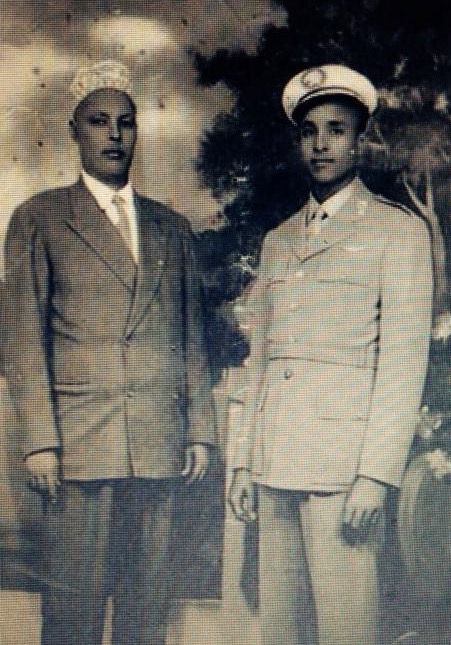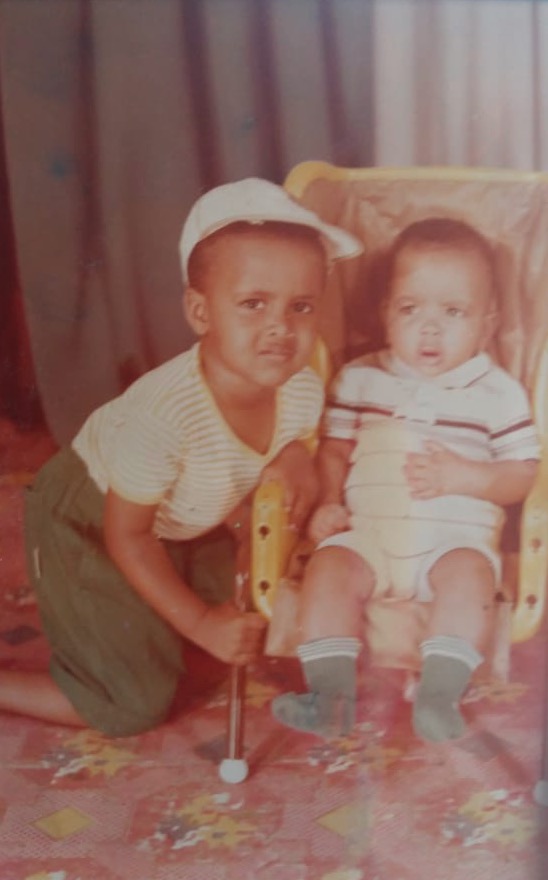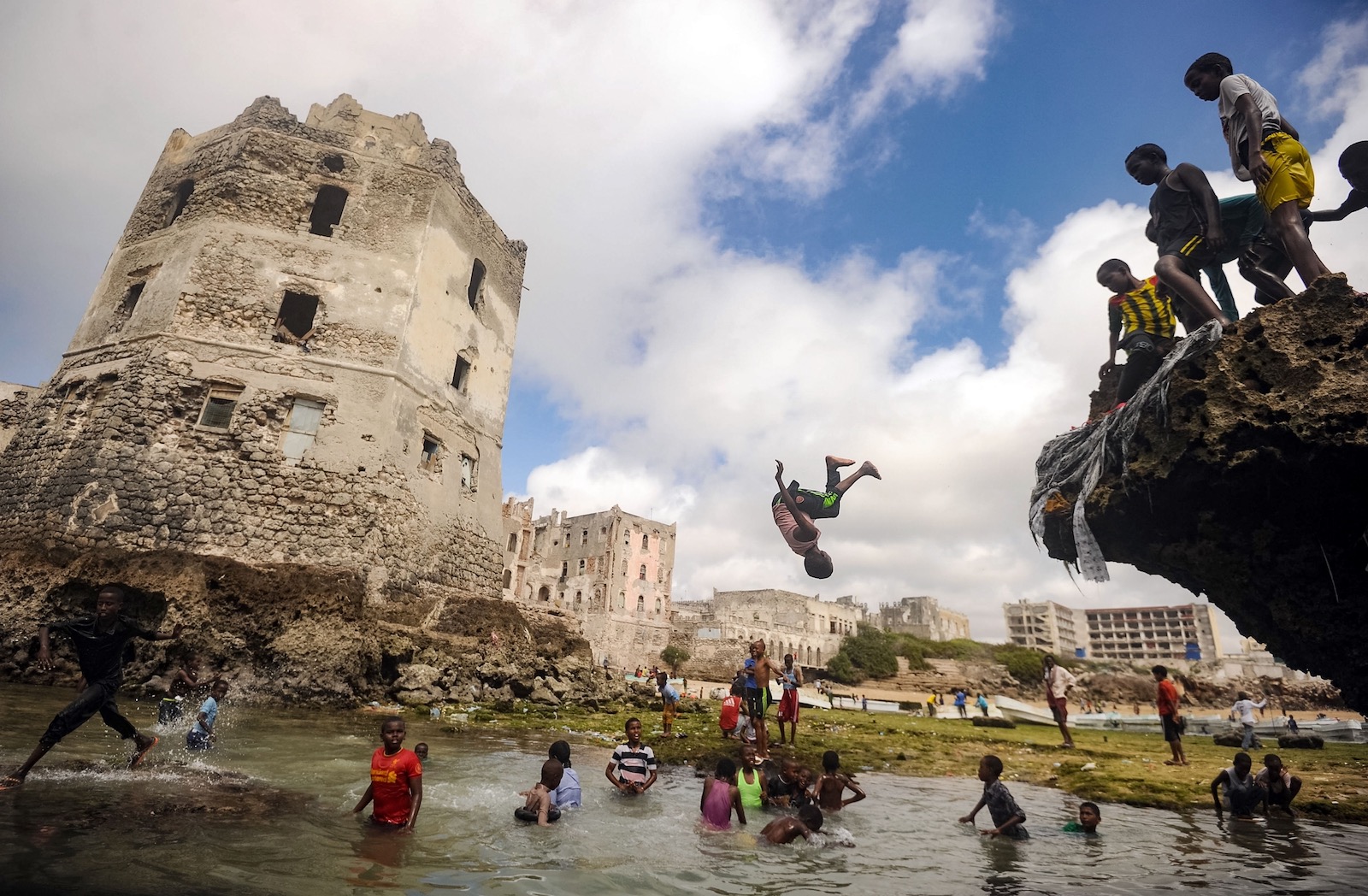NAIROBI, KENYA—From my home here, I watch the news about Black Lives Matter protests in the US and I see the protesters’ rage, unvarnished and unmitigated. I remember how I first came to learn of this rage. How I came to take on its weight.
When my family first immigrated to the US from Somalia via Canada, we were placed by a refugee agency in Buffalo, New York, in a government-subsidized property located in one of the city’s seedier neighborhoods. Our neighbor Trey, a hulking giant of a man and a trainer at a local boxing club, had quickly come to befriend and watch over this strange family from this strange country he had never heard of. One day, he took my brother and me shopping for school supplies. I must have been around thirteen at the time.
I remember walking alongside him on the crumbling sidewalk, amid a forest of run-down houses, and Trey nodding his head toward a police car idling across the street. “Look at that motherfucker over there. Just waiting to pounce.” I remember this distinctly, for it was the first time I’d heard an adult use the word—and with such violent emphasis: the strong “f” and a gutteral “k.”
Later, when we entered our first store, he pointed out a white clerk, who was noticeably craning his neck to follow our path through the aisles. “See the way he’s staring? Probably thinks we’re stealing something,” he said, his voice simmering with anger.
He continued in a similar fashion throughout the day as he took us from store to store, providing a running commentary on, what seemed to me, imagined slights and threats, in a strange, one-sided conversation.
In Somalia, we knew African Americans only through popular Hollywood movies, like Rambo and Rocky, in which they were the comic sidekicks or inept villains. They were peculiar, alien caricatures to us.
My parents handed down to me stories and histories of my grandparents and their struggles under Italy’s colonial administration. My mother would often show me a black-and-white picture of my grandfather in military uniform, and tell me how he was thrown in jail by the colonial police for talking back to an Italian officer. She described how he’d fought for independence. In school, we were taught about our great national heroes—such as Hawo Tako, who had taken up arms against our colonial oppressors and gone into battle with her newborn strapped to her back. (Our textbooks and media also taught us to venerate our president, Siad Barre, though, in reality, many thought him a brutal dictator.)
It was a very different world from the one that Trey knew. But I would come to know his soon enough.
My father had been an army officer in Somalia—though he later defected from Barre’s forces before the outbreak of the country’s two decades-long civil conflict. But in those pre-war days, he would occasionally host foreign diplomats at our house, some of them Americans. Those few, white and ruddy-faced, that I had occasion to meet all seemed loud and preternaturally happy. And they would often bring gifts.
One evening, one such guest handed me a carefully wrapped metal figurine of a robed woman holding a flame aloft, explaining, through my father’s halting translation, how this woman represented liberty, opportunity, and the American way. My brothers received similar figurines, of the Empire State Building and the Golden Gate bridge. My father later explained that these Americans were helping us do important work in strengthening our nation, and how, one day, with their support, we, too, would enjoy the might and prosperity of America.
Then, in 1989, civil war broke out. As violence began to spread throughout the country, my family and many others were forced to flee abroad. And so we were pitched across the Atlantic, to the America I’d long imagined, of Coca-Cola, cowboys, and grinning white men who spoke of wealth, ambition, and towering buildings that touched the sky.
After our brief sojourn in Buffalo, we were placed with a French-Canadian couple in Alburgh, Vermont, a small town that perched on a narrow peninsula on the eastern shore of Lake Champlain. My refugee family, together with a morose-looking Eritrean man, who mostly kept to himself, were the only lodgers at the couple’s home that summer. Sometimes, the place moonlighted as a bed and breakfast when the occasional lone tourist wandered in; otherwise, it ran as a halfway house for newly resettled refugees before they found more permanent homes.
Advertisement
Needing to occupy the time of her five restless children, my mother took to us to ransack the local library for books. On our way back, we heard the sound of a car coming and moved to the side of the road to let it pass. But instead of passing, it slowed down to match our pace.
It was the local police. Rolling down the window, a beefy, red-faced man shouted out: “I take it you folks aren’t from around these parts.” We all stopped and stared. The open-ended question momentarily confused us and we stared at him for a good few seconds without responding.
After my mother carefully explained who we were, why we were there, and where we lived, he hesitated for a moment, staring at these five kids with their bulging bags and at my mother with her bright-red garbasaar billowing in the wind.
“Well, why don’t you hop on in,” he said. “I’ll give you a ride.” This was a statement, not a question, we finally understood. I remember all of us stuffed into the back of the car, staring through the grill at our mother, who sat in the passenger seat, for lack of space, her back rigid. Later, when the officer dropped us off at our house and walked us to the door, our host looked embarrassed as she ushered us in. Once the police officer had gone, she apologized but insisted that he meant well and was just being friendly.
I did not believe her, for I remembered Trey’s words, and his rage.
*
In Somalia, my blackness was like the blueness of the sky: it was always there, an immutable fixture in the world, and so there was no reason to dwell upon it. Why would I?
In America, though, I became acutely conscious of it. How it shaped and twisted my path through the world. How it came to determine the texture and flavor of every moment in life, from the very small to very big. How it shaded every human connection I sought to make.
When, in my first job at a law firm, someone mistook me for a mail courier one day, I did not think myself paranoid for believing he had not simply made an honest mistake. When, as I was preparing to give my TED Talk at a venue, a white security guard told me that catering staff had to go through the back, I did not think I had imagined the dismissive look in his eyes. And when, like Trey, I enter a store and feel the clerk’s eyes trailing me, I do not believe myself to be having a one-sided conversation when I guess the thoughts running through his mind.
We are like leopards, my father once told me: the dappled skin, which once made us indistinguishable from the tall savannah grass, now, in our new home, only serves to point us out.
“I warned him again and again to stay away from those black kids,” the woman before me in my office lamented in Somali, nervously fiddling with the hem of her jilbaab. This was in the early 2000s, when I was working as a community rights activist in Columbus, Ohio, where my family—along with more than 40,000 other Somali immigrants, many of them also refugees—had carved out a home.
The woman was talking of her son, who had been arrested for drug possession. She described to me what she thought were the early signs of his deterioration: overhearing him use the word “nigger” on the phone, the steady beats of hip-hop trickling through his bedroom door, and his anger, always this strange anger, which she just could not comprehend. Once his case was resolved, she explained, she would take him back to her family’s village in Somalia for “Dhaqancelis” (literally, cultural rehabilitation)—to reconnect with the ways of his people. Perhaps then, she hoped, he would be purged of this poison.
Many of us, when we first came to the US, were placed in poor black neighborhoods that had a legacy of crime, imprisonment, and over-policing. We looked at how our neighbors suffered, and we thought: we are not them, we will not become them. To assimilate was to become black, and to become black, well, that was unimaginable.
And so we encased ourselves in our Somali identity, as a shield against becoming black in America. In high school, there was a Somali table at the cafeteria. Later, in college, I remember sitting in the library, a group of five or six other Somali students huddled around me, filling out the paperwork for what would be the first Somali Student Association at our university. We went to deliver the papers as a group, handing it over with much ceremony to a befuddled clerk.
Advertisement
“Finally, a space of our own,” someone said. There was, of course, the black student association, but we were Somali and we wanted others to see us as such. This was, however, no more than a line in the sand, soon swept away by the implacable tide.
During my second year of law school in Boston, I was invited for an interview at a large Manhattan law firm. I took the bus from Boston to New York and, from there, the subway to Brooklyn, where a friend had invited me to stay at his apartment. It was late and I must have been a block or so away from his apartment when I heard a muffled shout. It took me a second to register it as a command to stop when I heard rapid steps behind me. I was slammed against the wall, one arm pulled behind my back, my bag roughly dragged from my shoulder.
With my head pressed against the wall, I remember stupidly thinking I was being robbed—before the staccato fire of questions began: name, ID, where, what, why.
Police.
Afterward, I remember breathing heavily, staring down at my clothes, books, and other belongings scattered on the sidewalk. I tasted the coppery tang of blood blooming in my mouth, as I tried to divine some meaning in the pattern of all my things spread out before me.
And I remembered Trey’s rage. It is a rage that fills you up, winds you up, and holds you so tight that you sometimes feel you cannot think or breathe. It simmers and chafes until it suddenly bursts forth. But you hold onto it so tightly, for it is better than the alternative: a crippling fear. It is a rage that has trickled down through generations of black men and black women in the United States, stretching back to the arrival of the first slave ship at Jamestown, Virginia, all those centuries ago.
I am Somali, I am African, I am a refugee of war. This is my history. But every time I go out my door in America, a 400-year history of generational pain, anger, and trauma is foisted upon me. It has weighed down every step I’ve taken there. It made me stumble when I sought to stride.
*
I would eventually move back to East Africa, initially to stay in Somalia and later to make my home in Kenya, in search of something I couldn’t quite define. I recall a moment during my first week in Mogadishu, which was, in fact, the first time I’d been back since my family’s departure, a quarter-century earlier. I was at Secondo Lido beach, a small slice of white sand hidden by large rocky outcrops near Hamar Weyne, an old quarter of the city notable for its curious blend of Arab and Italian architecture still visible despite the attrition of war.
In the middle of the emerald green waters of the cove were the remains of a Russian-made battle tank, its rusting turret and large gun barrel peeking out from the water. Young street urchins would scramble up and jump off its side with great big whoops. I don’t know what came over me, but I suddenly found myself taking off my shirt and jumping into the water. I was standing on the slippery hide of the tank before I knew it, took a breath, and dived.
I resurfaced, spluttering salty water and grinning from ear to ear like one of the street kids. As I waded in the warm water, the reflection of the sun dazzling my eyes, the kids around me howling in delight, I saw my uncle Jama in the distance holding my shirt and shaking his head at my foreign strangeness. I thought then, once more, of Trey’s rage, of how I now carried it, too, of how I came to bear its weight, and of how, in that breathless moment, it had all seemed to slip away into the depths of those emerald green waters.
As we drove back home, my uncle pointed out the promenade along the sea shore.
“This was the piazza where we held independence day celebrations in the Sixties,” he said, and went on to tell me more of that incident that had gotten my grandfather arrested so long ago.
In the colonial period, grandfather had studied in Rome, and later he worked under the Italian-administered UN trusteeship as a pilot before independence. He was fluent in Italian and a model soldier. One day, fed up with being treated as a second-class citizen in his own country, his anger got the better of him and he punched an Italian man in the face during a traffic incident.
In Somalia, strangers often ask me why I returned, as they customarily do of diasporan Somalis who come back. “You are like Adam who has chosen to leave God’s fruitful garden,” they say, a joke common among those who never left.
As I watch events unfolding in the United States from this African vantage-point, I think of how, in those first days back in Mogadishu, as I again walked among those whose skin was indistinguishable from mine, the weight of that rage, the stifling weight I carried of trying to belong, of stooping to be less threatening, of the futility of trying to escape the burden of my blackness, all seemed to dissolve in the wet heat of the city.
I have come to have a lightness in my step, long-forgotten, that has made me wonder: Is this the way white people feel in America?





